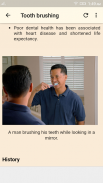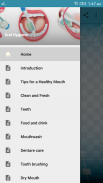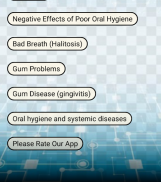








Oral Hygiene

Mô tả của Oral Hygiene
Oral hygiene is the practice of keeping one's mouth clean and free of disease and other problems (e.g. bad breath) by regular brushing and cleaning between the teeth.
It is important that oral hygiene be carried out on a regular basis to enable prevention of dental disease.
The most common types of dental disease are tooth decay (cavities, dental caries) and gum diseases, including gingivitis, and periodontitis
Regular brushing consists of brushing twice a day: after breakfast and before going to bed. Cleaning between the teeth is called interdental cleaning and is as important as tooth brushing
This is because a toothbrush cannot reach between the teeth and therefore only cleans 50% of the surfaces
Vệ sinh răng miệng là thực hành giữ miệng sạch và không bị bệnh và các vấn đề khác (ví dụ như hơi thở hôi) bằng cách đánh răng và lau chùi giữa răng.
Điều quan trọng là vệ sinh răng miệng phải được thực hiện thường xuyên để giúp phòng ngừa bệnh răng miệng.
Các loại bệnh răng miệng phổ biến nhất là sâu răng (sâu răng, sâu răng) và các bệnh về nướu, bao gồm viêm nướu, và viêm nha chu
Thường xuyên đánh răng bao gồm đánh răng hai lần một ngày: sau bữa ăn sáng và trước khi đi ngủ. Làm sạch giữa các răng được gọi là làm sạch kẽ răng và cũng quan trọng như việc đánh răng
Điều này là do bàn chải đánh răng không thể tiếp cận giữa răng và do đó chỉ làm sạch 50% bề mặt

























